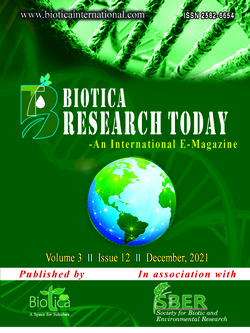
Editing the Genome for Salt Tolerance in Rice
Sourav Priyadarsi Tripathy
Center for Biotechnology, Siksha ‘O’ Anusandhan Deemed to be University, Bhubaneswar, Odisha (751 003), India
Prasanta Kumar Majhi*
Dept. of Plant Breeding and Genetics, Regional Research and Technology Transfer Station, Odisha University of Agriculture and Technology, Keonjhar, Odisha (758 002), India
Biswaranjan Patra
Center for Biotechnology, Siksha ‘O’ Anusandhan Deemed to be University, Bhubaneswar, Odisha (751 003), India
Afreen Khan
Center for Biotechnology, Siksha ‘O’ Anusandhan Deemed to be University, Bhubaneswar, Odisha (751 003), India
Swagat Kumar Tripathy
Center for Biotechnology, Siksha ‘O’ Anusandhan Deemed to be University, Bhubaneswar, Odisha (751 003), India
DOI: NIL
Keywords: CRISPR-Cas, Genome editing, Rice, Salt tolerance
Abstract
Rice is considered as a major food crop in the World and provides 20% of the world’s dietary energy. Development of abiotic stress tolerance rice genotypes including salt tolerance is very much necessary for sustainable rice production under climate change scenario. Ground salt is one of the most important barriers to rice production worldwide, especially in coastal areas. Rice has benefited from new breeding technologies, such as the CRISPR-led evolution, CRISPR-Cas, and basic editors, have recently been used in rice to achieve successful genome sequencing. In this way we can focus on the editing of genome for salt tolerance rice and find out the best source based on its conventional and advanced method to improve its resistant effect along with its productivity which can be widespread all over the sites.
Downloads
not found
Reference
Feng, Z., Zhang, B., Ding, W., Liu, X., Yang, D., Wei, P., Cao, F., Zhu, S., Zhang, F., Mao, Y., Zhu, J., 2013. Efficient genome editing in plants using a CRISPR/Cas system. Cell Research 23, 1229-1232.
Miao, C., Xiao, L., Hua, K., Zou, C., Zhao, Y., Bressan, R.A., Zhu, J.K., 2018. Mutations in a subfamily of abscisic acid receptor genes promote rice growth and productivity. Proceedings of National Academy of Sciences USA 115, 6058-6063.
Ray, D.K., Mueller, N.D., West, P.C., Foley, J.A., 2013. Yield trends are insufficient to double global crop production by 2050. PLoS ONE 8(6), e66428.
Takagi, H., Tamiru, M., Abe, A., Kentaro, Yoshida, K., Uemura, A., Yaegashi, H., Obara, T., Oikawa, K., Hiroe Utsushi, H., Eiko Kanzaki, E., Mitsuoka, C., Natsume, S., Kosugi, S., Kanzaki, H., Matsumura, H., Urasaki, N., Kamoun, S., Terauchi, R., 2015. MutMap accelerates breeding of a salt-tolerant rice cultivar. Nature Biotechnology 33(5), 445-449.
Zhang, A., Liu, Y., Wang, F., Li, T., Chen, Z., Kong, D., Bi, J., Zhang, F., Luo, X., Wang, J., Tang, J., 2019. Enhanced rice salinity tolerance via CRISPR/Cas9-targeted mutagenesis of the OsRR22 gene. Molecular Breeding 39, 47.
